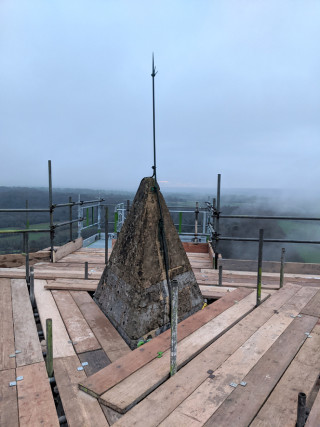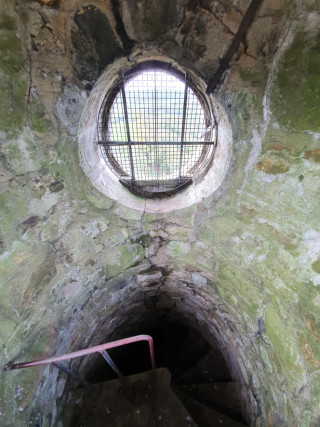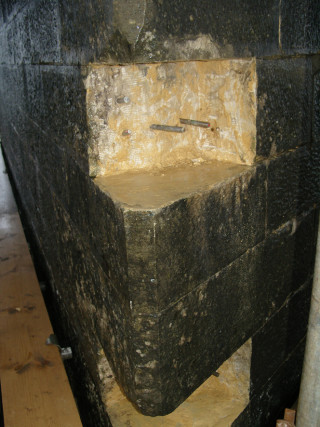Anybody who regularly uses the M5 motorway between junctions 26 and 27 will be familiar with the Wellington Monument. Built as a tribute to the Duke of Wellington following his victory at the Battle of Waterloo, the monument is, at 53m, the world’s tallest three-sided obelisk. And sitting on an exposed hilltop overlooking the motorway 1km to the north, it’s hard to miss as you drive past.
The monument is especially conspicuous right now because it is surrounded by a complex latticework of scaffolding, the essential means of access for a team of masons and conservation experts carrying out a £3.45m restoration project.
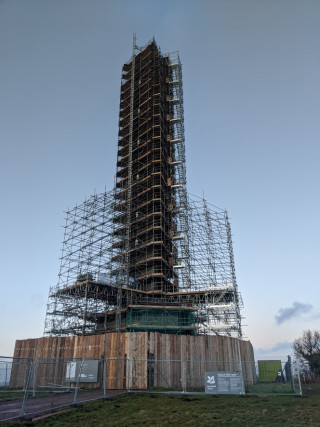
Although originally intended as a tribute to the Iron Duke, the obelisk has subsequently proved to be something of a white elephant for those responsible for its maintenance.
The original design, by a local architect, Thomas Lee, proposed a triangular pillar mounted on a plinth and surmounted by a massive cast iron statue of the Duke himself. The first stone was laid in 1817 but the money ran out within months and work had to stop when the pillar was still only about 14m high.
Henceforth, work continued in fits and starts and although the completed pillar did eventually reach its design height of 43m, the iron statue never materialised. Instead, the column was finished off with a triangular stone point, called a ‘pyramidion’.
The monument reached practical completion in 1820 although, by then, public interest in the project had waned. Even the popularity of the Duke himself was beginning to cool off. In 1828, he resigned as commander-in-chief of the British Army to become prime minister – and he proved to be a lot less popular as a politician than he had been as a soldier.
His monument, meanwhile, continued to prove problematic, attracting lightning strikes and generally showing a tendency to fall into disrepair. The first major repair project coincided with Wellington’s death in 1852.
Forty years later, in 1892, another major rebuild was carried out and this time the column was extended to the height we see today. Ever since, the monument has required ongoing maintenance, with major repairs usually required every 25 to 30 years.
The National Trust took over responsibility for the monument in 1934 and the current project is the latest and most extensive restoration it has undertaken. “This should be the last 30-year rebuild,” says Jonah Jay, the Trust’s lead surveyor on the project.
The monument – now listed Grade II* – comprises the tapering three-sided obelisk sitting on top of a large triangular splayed plinth in the Eqyptian style. Built from rough chert rubble, the entire structure is faced with grey limestone blocks quarried locally at Whitestaunton, near Chard.
The monument is hollow, with access via a tall iron door in the plinth, and a spiral staircase leads all the way to the underside of the pyramidion where three open circular windows, one in each face, offer views over the surrounding countryside.
Before the current restoration work could be specified, the entire structure was carefully inspected inside and out. Rope access methods were used to inspect the external faces and ground-penetrating radar equipment was brought in to ‘see’ inside the masonry and detect voids and faults.
A complex scaffold structure had to be erected to provide comprehensive access to the entire external structure of the monument before the main contractor, Wells-based Sally Strachey Historic Conservation (SSHC), could start work.
The scaffold was assembled over a period of eight-and-a-half weeks, from October to December 2019, by Exeter-based contractor Apex Scaffolding. No work could get underway until the scaffolding was up, says Apex Scaffolding’s estimator, Adam Bussell. “We started on site even before the site office was up or the trees trimmed back,” he says.
Public access to the base of the monument has been fenced off for several years, but once the scaffolding started to go up, a more robust barrier was soon needed. The remote location of the hill-top site, surrounded by woods and several hundred metres from the nearest habitation, makes security a major concern.
“We’ve had a bit of trouble with people breaking in,” says Jay. There have even been reports of people attempting to base-jump from the incomplete scaffold. Hence the base of the monument is now surrounded by a forbidding 4m palisade of scaffold boards to keep unwanted visitors at bay.

Design of the scaffolding – which Apex subcontracted to Bristol-based specialist Optima Scaffolding Design – was also less than straightforward. Space to work on the narrow scaffold around the obelisk is limited but access along the decking needs to be clear to permit large stones to be manoeuvred into place. The diagonal ledger-bracing normally employed would have cut across the working area and created an obstruction.
Optima’s solution was to brace the structure with horizontal members under each transom and, while this has effectively reduced the height between lifts, it frees up space in which the contractor can work.
Normally a scaffold of this height would be tied into the building for support, but this could not be done on this project due to the fragility of the obelisk. Optima’s design therefore minimises contact between the scaffold and the monument itself. “Essentially, the scaffolding’s free-standing up to 30m, with the top third of the scaffold butted up to the column, but not tied in,” explains Bussell.
The lower, free-standing, section of scaffolding extends out way beyond the footprint of the monument to buttress the whole structure; it then narrows abruptly to hug the upper section of the obelisk. “That’s why it looks like a giant rocket ship,” says Bussell.
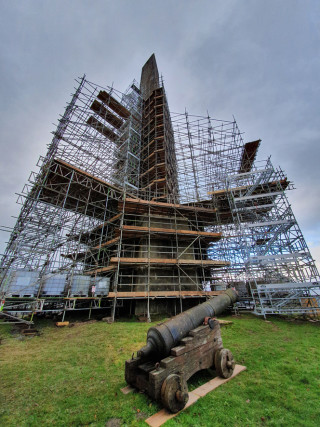
Stability for the free-standing scaffold is provided by approximately 30 tonnes of kentledge in the form of 10 water-filled IBC containers located on the scaffold at the base of each of the three faces.
The highly exposed location on top of the Blackdown Hills means high wind speeds are frequent and considerable. The use of debris netting, normally a routine provision, was out of the question on this project except in specific, and very limited, circumstances.
“Optima’s design allows us to use localised netting in certain areas when necessary,” explains Bussell. But any such protection can only be provided when winds are below a certain speed and so work that requires this level of protection must be carefully planned.
Even the work itself is constrained by the weather. Once the wind speed exceeds about 25mph, nobody can work on the upper lifts of the scaffolding.
Although netting cannot be installed permanently, protection against falling debris is still necessary so this is afforded by timber fanning built out from the lower scaffold levels.
Two electric hoists, supplied by local firm Hoist Hire from its depot in Buckfastleigh, provide access for materials and personnel. To get to the base of the obelisk, on top of the 8m-high plinth, workers use a modular Haki staircase while tools and materials are brought up via an electric hoist.
The second hoist, for both goods and personnel, extends from the base of the plinth to the top of the obelisk. “This is the biggest single-tower hoist we could get,” says Bussell. It has a lifting capacity of
one tonne and will be used to hoist the largest stones – weighing up to 850kg – to the top of the tower.
Moving the masonry around the scaffold is done with a combination of wooden rollers and a simple trolley. The heaviest items are loaded on and off the hoist using a hydraulic lift. “For really heavy stones, we might need to employ extra temporary works, such as a chain block or electric hoist,” says John Mullins, one of the masons at SSHC.

The work being carried out by SSHC consists largely of traditional masonry repair, such as raking out joints and repointing, but several stones must be completely replaced with new masonry. Every single stone has been inspected and recorded and the repair extends from individual stones to entire sections.
“There’s one large area dating from the 1950s that is basically one big lump of concrete,” says Jay. “I think that the damage they found was so bad that they just panicked and were at a loss to know what else to do”.
The scaffolding, comprising around eight miles of tube, 3,000 boards and 23,000 fittings, is expected to remain in place for 72 weeks; completion is scheduled for Easter 2021.
Project Team
The £3.45m Wellington Monument restoration project has secured most of its funding from major donors including the Treasury, Historic England and Highways England, as well as private donations. Fundraising continues and is currently about £500,000 short of its target.
Client: The National Trust
Main contractor: Sally Strachey Historic Conservation
Scaffolding: Apex Scaffolding
Scaffold design: Optima Scaffolding Design
Architect: Inskip Gee
Engineer: Mann Williams
No stone unturned
Most of SSHC’s work involves routine repointing of the hard sandstone outer skin of the structure which, in some places, is just 50mm thick.
Other areas require complete replacement, especially along the sharp 60o edges of the obelisk where stones have cracked under high compressive forces as the column flexes in the wind. New stone comes from Lovell Stone’s Chilmark Quarry in Wiltshire.
Deterioration has also resulted from rainwater penetrating joints and scouring out channels, creating voids and weakening the structure.
To remedy this, SSHC is using hand pumps to inject a grout through tubes into the stonework to fill the voids and consolidate the masonry. The grout is a hydraulic lime (NHL2) mix with pulverised fuel-ash (PFA) as a pozzolanic binder for a chemical set. “The PFA also helps the grout to flow more easily,” explains SSHC team leader John Mullins.
Perhaps the most challenging part of the works will be the dismantling and replacement of the pyramidion, right at the very top of the column.
These stones were laid sloping at an angle towards the centre axis of the obelisk – the idea being that gravity would hold the entire structure tightly together.
Similarly, the massive 850kg capstone is held down with a heavy stone counterweight suspended beneath it, inside the column, from an iron bar.
While this arrangement holds everything together effectively, the angled joints in the stonework encourage water to penetrate the pyramidion and erode the masonry. SSHC is therefore completely rebuilding the pyramidion from scratch – with horizontal jointing and no counterweight below the new capstone.
Apex scaffolding
Although Exeter-based Apex Scaffolding seldom ventures far beyond the South West, it has a strong presence on its home turf and an enviable list of repeat customers.
“We don’t specialise in heritage projects necessarily, but we do target high-profile, prestige projects,” says estimator Adam Bussell. “We have long-standing relationships with both Sally Strachey and the National Trust,” he adds.
Besides the Wellington Monument, one of Apex Scaffolding’s most visible projects is on the reconstruction of Exeter’s Royal Clarence Hotel (above) which was gutted by fire in 2016.
Having worked with the hotel in the past, and with good connections with the local authority, emergency services and local structural engineers, Apex was called in to design a scheme that would both support and protect the remaining structures and allow access for stabilisation works.
All of this was to be carried in the shortest time possible as the location meant several important pedestrian thoroughfares had to be closed, with a detrimental impact on other local businesses.
Working to designs by Optima Scaffolding Design, Apex completed its installation, which included a protection tunnel to Martins Lane and a drive-through gantry buttress on Cathedral Yard, in just eight days.
Restoration work on the hotel, which is now up for sale, has been suspended but Apex – which won last year’s NASC Health & Safety Award – continues to carry out weekly inspections.
This article was first published in the February 2020 issue of The Construction Index magazine (magazine published online, 25th of each month.)
UK readers can have their own copy of the magazine, in real paper, posted through their letterbox each month by taking out an annual subscription for just £50 a year. Click for details.
Got a story? Email news@theconstructionindex.co.uk


